NIH Biosketch
Information on NIH Biosketches.
As of January 25, 2022, you are now required to use the new Biosketch Format Page. This page focuses on the new format changes in Biosketches. NIH encourages investigators to utilize SciENcv to develop their Biosketch which the system will automatically format according to NIH requirements.Note, NIH does reserve the right to not review your submitted application if any of the Biosketches in your application do not follow the new format. They will be considered non-compliant.Background
Training Sessions
On March 30, 2021, a Quarterly Contacts Meeting was held where upcoming changes were discussed. Since then, NIH released the above clarification notice that this new form was requested to be used for deadlines on or after May 25, 2021, and that it firmly is required for deadlines on or after January 25, 2022. Additionally, on November 10, 2021, and January 12, 2022, the topic was presented for the campus-wide Research Compliance Hot Topics and Training Program on the upcoming changes. A copy of the presentations and recordings can be found below:
- Quarterly Contracts Meeting, March 30, 2021 (PDF)
- Research Compliance Hot Topics Biosketch Changes, November 2021 (PDF)
- Research Compliance Hot Topics Biosketch Changes, November 2021 (Recording, login)
- Research Compliance Hot Topics Biosketch Changes, January 2022 (PDF)
- Research Compliance Hot Topics Biosketch Changes, January 2022 (Recording, login)
Resources
- Biosketch Form Page Overview
- Biosketch Form Pages
- Instructions: New Biosketch Form Page (Word)
- Biosketch FAQs
- NIH Pre-award and Post-award Disclosures Relating to the Biographical Sketch and Other Support (updated 6/8/2022, PDF)
- Examples of What to Disclose to NIH about Senior/Key Personnel on Applications and Awards Table
New Biosketch Format Detailed Information, Including a Walk-Through
Non-Fellowship Biosketches and/or Fellowship Biosketches are required in both competing applications and progress reports. The new Non-Fellowship Biosketch form is broken down into four sections: 1. Informational Table, including Education; 2. Personal Statement; 3. Positions, Scientific Appointments, and Honors; and 4. Contributions to Sciences; and the new Fellowship Biosketch form is still broken down into five sections: 1. Informational Table, including Education; 2. Personal Statement; 3. Positions, Scientific Appointments, and Honors; 4. Contributions to Sciences; and 5. Scholastic Performance.
All sections combined can be no more than five pages, with 1/2 inch margins and in one of the four preferred NIH Font types and size.
As stated above, for Non-Fellowship applications & Fellowship applications, the Information, Education, and Sections A-C are the same. Section D is only for Fellowship Applications. The first section includes a table located at the top of the first page and it contains the name, title, eRA Commons ID, and education/training (including locations) of the person the biosketch is for.
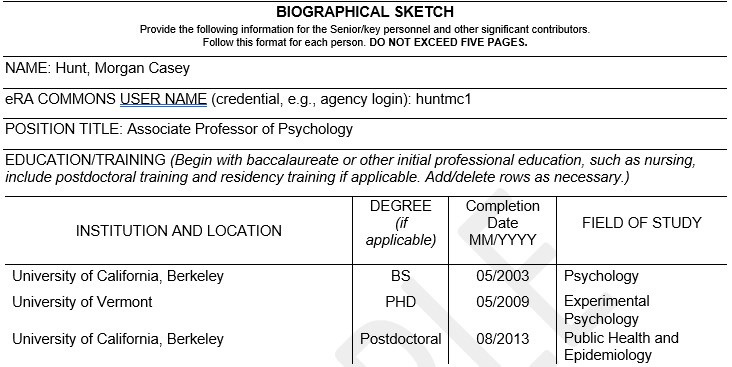
The next section is the person's Personal Statement. Here, you briefly describe why this person is well-suited for their role(s) in this project. Relevant factors may include: aspects of their training; their previous experimental work on this specific topic or related topics; their technical expertise; their collaborators or scientific environment; and/or their past performance in this or related fields. Additionally, they may cite up to four publications or research products that highlight their experience and qualifications for this project. Moreover, you now can highlight recently completed or active research support here as well. There is no limit to the number of research support activities you can highlight. Note, in the sample shown here, the aims of the highlighted research does not need to be detailed. Just the basic detailed are highlights.
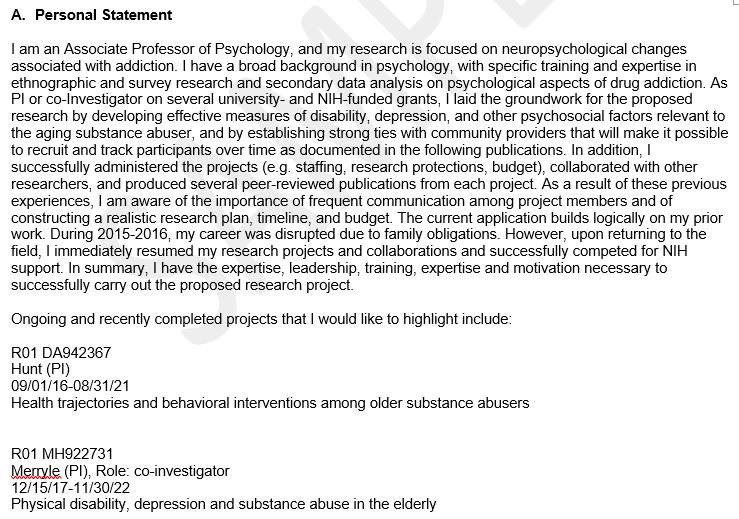
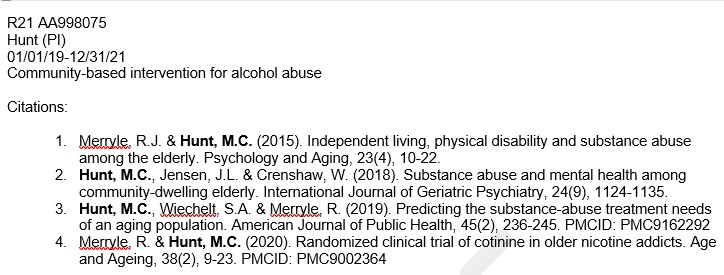
After the Personal Statement, you have the updated section on Positions, Scientific Appointments, and Honors. Here, you list in reverse chronological order ALL CURRENT positions and scientific appointments, both domestic and foreign, including affiliations with foreign entities or governments. This includes titled academic, professional, or institutional appointments whether or not remuneration is received, and whether full-time, part-time, or voluntary (including adjunct, visiting, or honorary).
In particular:
- Students, post doctorates, and junior faculty should include scholarships, traineeships, fellowships, and development awards, as applicable.
- Clinicians should include information on any clinical licensures and specialty board certifications that they have achieved.
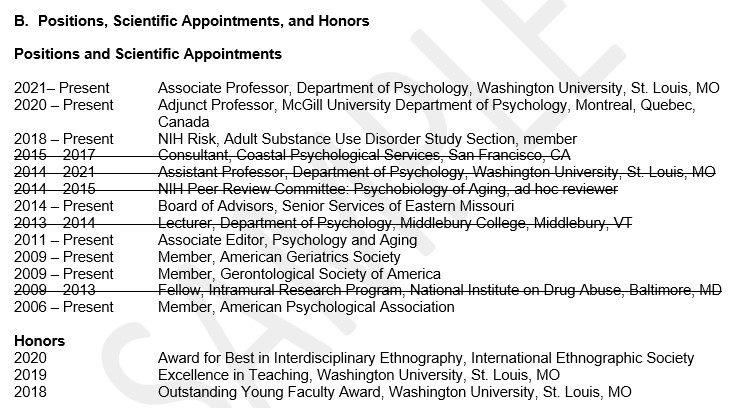
Then, you have the section on Contributions to Science. All senior/key persons should complete the "Contributions to Science" section except candidates for research supplements to promote diversity in health-related research who are high school students, undergraduates, and post-baccalaureates.
- the historical background that frames the scientific problem;
- the central finding(s);
- the influence of the finding(s) on the progress of science or the application of those finding(s) to health or technology; and
- your specific role in the described work.
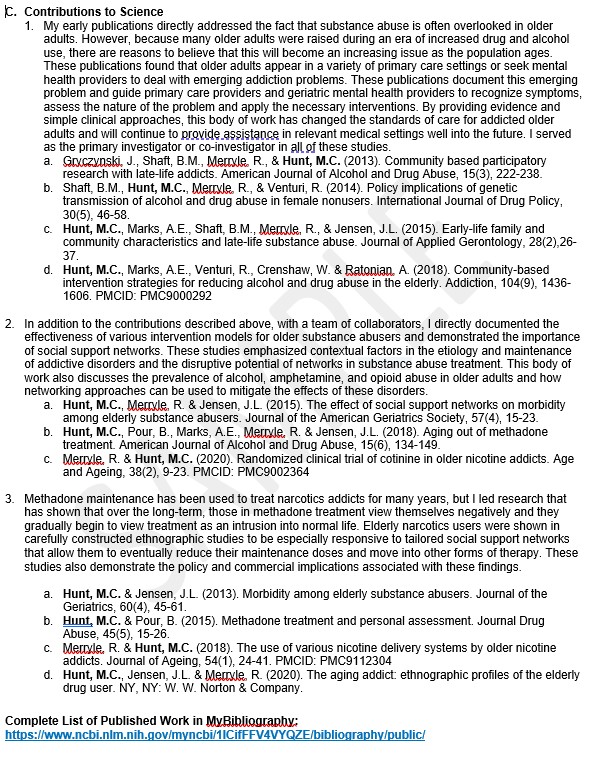
For Non-Fellowship Applications, the above Section C. would be the end of the Biosketch, but for Fellowship applications, we would still have the additional section: D. Scholastic Performance. Note the following instructions for specific subsets of applicants/candidates:
- High school students are not required to complete Section D. Additional Information: Research Support and/or Scholastic Performance.
- Career development award applicants should are not Fellowship applications and thus would not use a Fellowship Biosketch and they would skip the D. Scholastic Performance section.
- Generally, the following types of applicants must complete only the "Scholastic Performance" section:
- Applicants for predoctoral and postdoctoral fellowships
- Applicants to dissertation research grants (e.g., R36)
- Candidates for research supplements to promote diversity in health-related research from the undergraduate through postdoctoral levels
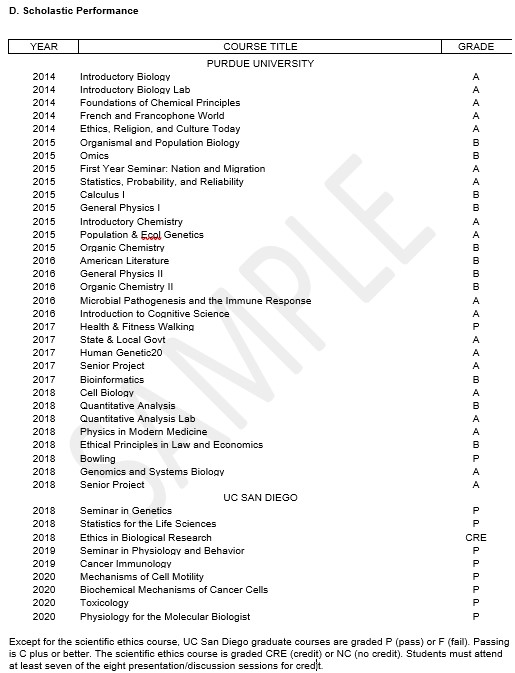
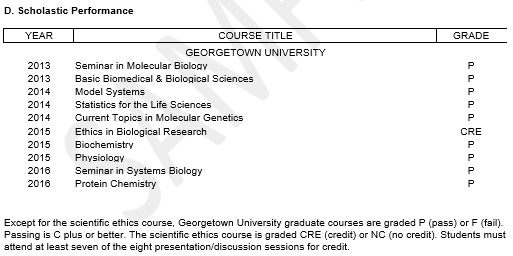
For more information or questions email researchadmin@ucsd.edu.